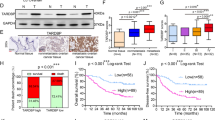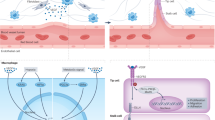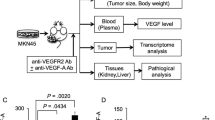Abstract
Vascular endothelial growth factor (VEGF) is known to occur as at least six differentially spliced variants, giving rise to mature isoforms containing 121, 145, 165, 183, 189 and 206 amino acids. However, little is yet known concerning the in vivo activities of this differential splicing. Stably transfected MCF-7 breast carcinoma cells were constructed that secreted comparable amounts of the 121, 165 or 189 isoforms. Rabbit corneal angiogenesis assays showed the VEGF121 transfectant to have much greater angiogenic activity than the 165 or 189 expressing MCF-7 cells. While the VEGF121-expressing MCF-7 cells were reproducibly more tumorigenic than the control transfectants, this was not the case with the VEGF165- or VEGF189-expressing cells. More surprising was the observation that VEGF189 located to the nucleus, consistent with the presence of a highly conserved nuclear localization sequence in exon 6a that is expressed in VEGF189 but not 121 or 165. It was concluded that the VEGF121 isoform is both more angiogenic and tumorigenic than are the 165 and 189 isoforms. This is probably due to the ability of the 121 isoform, unlike the 165 and 189 isoforms, to freely diffuse from the cells producing it. © 2000 Cancer Research Campaign
Similar content being viewed by others
Article PDF
Change history
16 November 2011
This paper was modified 12 months after initial publication to switch to Creative Commons licence terms, as noted at publication
References
Acland P, Dixon M, Peters G and Dickson C (1990) Subcellular fate of the int-2 oncoprotein is determined by choice of initiation codon. Nature 343: 662–665
Bader T and Wiezerbin J (1994) Nuclear accumulation of interferon-γ. Proc Natl Acad Sci USA 91: 11831–11835
Bicknell R (1997) Mechanistic insights into tumour angiogenesis. In: Tumour Angiogenesis, Bicknell R, Lewis CE, Ferrara N (eds), pp. 19–28. Oxford University Press: Oxford
Carmeliet P, Ng Y-S, Nuyens D, Theilmeier G, Brusselmans K, Cornelissen I, Ehler E, Kakkar VV, Stalmans I, Mattot V, Perriard J-C, Dewerchin M, Flameng W, Nagy A, Lupu F, Moons L, Collen D, D’Amore PA and Shima DT (1999) Impaired myocardial angiogenesis and ischemic cardiomyopathy in mice lacking the vascular endothelial growth factor isoforms VEGF164 and VEGF188. Nature Med 5: 495–502
Cheung N, Wong MP, Yuen ST, Leung SY and Chung LP (1998) Tissue-specific expression pattern of vascular endothelial growth factor isoforms in the malignant transformation of lung and colon. Hum Pathol 29: 911–914
Coltrini D, Gualandris A and Nelli EE (1995) Growth advantage and vascularisation induced by basic fibrolblast growth factor overexpression in endometrial HEC-1-B cells: An export -dependent mechanism of action. Cancer Res 55: 4729–4738
Gimbrone MA Jr, Cotran RS, Leapman SB and Folkman J (1974) Tumor growth and neovascularisation: an experimental model using the rabbit cornea. J Natl Cancer Inst 52: 413–427
Gitay-Goren H, Cohen T, Tessler S, Soker S, Gengrinovitch S, Rockwell P, Klagsbrun M, Levi BZ and Neufeld G (1996) Selective binding of VEGF121 to one of the three vascular endothelial growth factor receptors of vascular endothelial cells. J Biol Chem 271: 5519–5523
Grutzkau A, Kruger-Krasagakes S, Baumeister H, Schwarz C, Kogel H, Welker P, Lippert U, Henz BM and Moller A (1998) Synthesis, storage and release of vascular endothelial growth factor/vascular permeability factor (VEGF/VPF) by human mast cells: implications for the biological significance of VEGF206. Mol Biol Cell 9: 875–884
Houck KA, Ferrara N, Winer J, Cachianes G, Li B and Leung DW (1991) The vascular endothelial growth factor family: identification of a fourth molecular species and characterisation of alternative splicing of RNA. Mol Endocrinol 5: 1806–1814
Houck KA, Leung DW, Rowland AM, Winer J and Ferrara N (1992) Dual regulation of vascular endothelial growth factor bioavailability genetic and proteolytic mechanisms. J Biol Chem 267: 26031–26037
Keyt BA, Berleau LT, Nguyen HV, Chen H, Heinsohn H, Vandlen R and Ferrara N (1996) The carboxyl-terminal domain (111–165) of vascular endothelial growth factor is critical for its mitogenic potency. J Biol Chem 271: 7788–7795
Lei J, Jiang A and Pei D (1998) Identification and characterisation of a new splicing variant of vascular endothelial growth factor: VEGF183. Biochim Biophys Acta 1443: 400–406
Neufeld G, Cohen T, Gengrinovitch S and Poltorak Z (1999) Vascular endothelial growth factor and its receptors. FASEB J 13: 9–22
Park JE, Keller GA and Ferrara N (1993) The vascular endothelial growth factor (VEGF) isoforms: differential deposition into the subepithelial extracellular matrix and bioactivity of extracellular matrix-bound VEGF. Mol Biol Cell 4: 1317–1326
Relf M, LeJeune S, Scott PAE, Fox S, Smith K, Leek R, Moghaddam A, Whitehouse R, Bicknell R and Harris AL (1997) Expression of the angiogenic factors vascular endothelial cell growth factor, acidic and basic fibroblast growth factor, transforming growth factor β-1, platelet-derived endothelial cell growth factor, placenta growth factor and pleiotrophin in human primary breast cancer and its relation to angiogenesis. Cancer Res 57: 963–969
Robbins J, Dilworth SM, Laskey RA and Dingwall C (1991) Two independent basic domains in nucleoplasmin nuclear targeting sequence: Identification of a class of bipartite nuclear targeting sequence. Cell 64: 615–623
Siemeister G, Schnurr B, Mohrs K, Schachtele C, Marme D and Martiny-Baron G (1996) Expression of biologically active isoforms of the tumor angiogenesis factor VEGF in Escherichia coli. Biochem Biophys Res Commun 222: 249–255
Smith K, Houlbrook S, Greenall M, Carmichael J and Harris AL (1993) Topoisomerase IIα coamplification with erbB-2 in human primary breast cancer and breast cancer cell lines: relationship to m-AMSA and mitoxantrone sensitivity. Oncogene 8: 933–938
Tischer E, Mitchell R, Hartman T, Silva M, Gospodarwicz D, Fiddes JC and Abraham JA (1991) The human gene for vascular endothelial growth factor. Multiple protein forms are encoded through alternative exon splicing. J Biol Chem 266: 11947–11954
Turley H, Scott PAE, Watts VM, Bicknell B, Harris AL and Gatter KG (1998) Expression of VEGF in routinely fixed material using a new monoclonal antibody VG1. J Pathol 186: 313–318
Zhang H, Craft P, Scott PAE, Ziche M, Weich HA, Harris AL and Bicknell R (1995) Enhancement of tumor growth and vascular density by transfection of vascular endothelial cell growth factor into MCF-7 human breast carcinoma cells. J Natl Cancer Inst 87: 213–219
Ziche M, Morbidelli L, Masini E, Amerini S, Granger HJ, Maggi CA, Geppetti P and Ledda F (1994) Nitric oxide mediates angiogenesis in vivo and endothelial cell growth and migration in vitro promoted by substance P. J Clin Invest 94: 2036–2044
Ziche M, Morbidelli L, Choudhuri R, Zhang H-T, Donnini S, Granger HJ and Bicknell R (1997) Nitric oxide-synthase lies downstream of vascular endothelial growth factor but not basic fibroblast growth factor induced angiogenesis. J Clin Invest 99: 2625–2634
Author information
Authors and Affiliations
Rights and permissions
From twelve months after its original publication, this work is licensed under the Creative Commons Attribution-NonCommercial-Share Alike 3.0 Unported License. To view a copy of this license, visit http://creativecommons.org/licenses/by-nc-sa/3.0/
About this article
Cite this article
Zhang, HT., Scott, P., Morbidelli, L. et al. The 121 amino acid isoform of vascular endothelial growth factor is more strongly tumorigenic than other splice variants in vivo. Br J Cancer 83, 63–68 (2000). https://doi.org/10.1054/bjoc.2000.1279
Received:
Revised:
Accepted:
Published:
Issue date:
DOI: https://doi.org/10.1054/bjoc.2000.1279
Keywords
This article is cited by
-
How VEGF-A and its splice variants affect breast cancer development – clinical implications
Cellular Oncology (2022)
-
Expression of vascular endothelial growth factor (VEGF) in equine sarcoid
BMC Veterinary Research (2018)
-
High expression of a novel splicing variant of VEGF, L-VEGF144 in glioblastoma multiforme is associated with a poorer prognosis in bevacizumab treatment
Journal of Neuro-Oncology (2018)
-
MDA-MB-231 breast cancer cells overexpressing single VEGF isoforms display distinct colonisation characteristics
British Journal of Cancer (2015)
-
Overexpression of VEGF183 promotes murine breast cancer cell proliferation in vitro and induces dilated intratumoral microvessels
Tumor Biology (2015)



